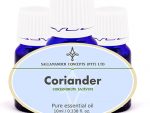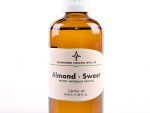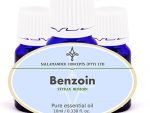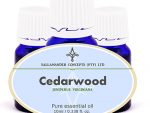Information on Myrrh Oleo Resin / Essential Oil
Our Myrrh essential oil is strictly an oleo resin and contains more therapeutic compounds.
Myrrh Oleo Resin is extracted from Commiphora myrrha (also known as Commiphora molmol and Balsamodendron myrrha) of the Burseraceae family and is also known as bola, myrrha, gum, common and hirabol myrrh.
If you talk about a magical oil in aromatherapy, then Myrrh Oil must surely be it, as it not only works on improving your spiritual self, but produces wonderful results when used to treat female complaints (though not during pregnancy of when breastfeeding), skin ailments, as well as detoxifying the body and expelling mucus and phlegm from the body
Oil Properties of Myrrh essential oil or Oleo Resin
Myrrh essential oil can have a warm, slightly musty smell and is pale yellow to amber in color. The Oleo Resin is thick and golden brown in colour.
Origin
Myrrh essential oil or the superior oleo resin is derived from a small tree that can grow up to 5 meters (16 feet) high with light bark and knotted branches, few leaves and small white flowers. It is native to Somalia, Arabia and Yemen.
When the bark is cut, the gum resin exudes as a pale yellow liquid, which dries into reddish-brown lumps,the size of a walnut from which the oil is eventually distilled.
Myrrh oleo resin (and some say Myrrh essential oil as well) was very popular in the ancient world and was used as a medicine by the Chinese and Egyptians, and as part of the Egyptian sun-worshiping ritual and mummification.
It was used in cosmetics, while Greek soldiers took a phial of Myrrh oleo resin oil with them into battle, to stop bleeding wounds.
Extraction
Myrrh Essential Oil is extracted by steam distillation of the oleoresin-gum (crude myrrh) and yields 3 – 5 %.
Myrrh oleo resin is created where the resin and the essential oil are mixed using a heat process.
Chemical composition
Some of the main chemical components of myrrh essential oil are Furanoeudesma-1,3-diene, Furanodiene, Lindestrene, β-Elemene, Germacrene B, Germacrene D, δ-Elemene
Precautions
Myrrh Oleo-resin and Myrrh essential oil is potentially fetotoxic and should not be used when breastfeeding or pregnant.
Please read our page with heading: Safety with Essential Oils before using this oil.
We recommend the following book as an excellent resource regarding safety:
Essential Oil Safety: A Guide for Health Care Professionals by Robert Tisserand & Rodney Young (#ad).
Therapeutic properties of Myrrh essential oil / Oleo resin
The therapeutic properties of Myrrh essential oil or oleo resim are anti-catarrhal, anti-inflammatory, antimicrobial, antiphlogistic, antiseptic, astringent, balsamic, carminative, cicatrisant, emmenagogue, expectorant, fungicidal, sedative, digestive and pulmonary stimulant, stomachic, tonic, uterine and vulnerary.
Uses
Myrrh Oil is effective against excessive mucus in the lungs and helps to clear ailments such as colds, catarrh, coughs, sore throats and bronchitis.
It is used for diarrhea, dyspepsia, flatulence and hemorrhoids (haemorrhoids).
It is very good for mouth and gum disorders, such as mouth ulcers, pyorrhea, gingivitis, spongy gums and sore throats.
On the skin, it is used with great success on boils, skin ulcers, bedsores, chapped and cracked skin, ringworm, weeping wounds, eczema and athlete’s foot.
Furthermore, it is of great help to promote menstruation and for relieving painful periods.
Burners and vaporizers
In vapor therapy, Myrrh Essential Oil can be useful with bronchitis, catarrh, colds and coughs. It is also great for enhancing spirituality and is most useful when meditating.
Blended Massage Oil and in the Bath
In a blended massage oil or diluted in the bath, myrrh oil is great for bronchitis, catarrh, colds, coughs and infections, as well as the female problems listed above. It also has a wonderful effect on the skin.
Mouthwash
It can be included when mixing a mouthwash for all dental infections.
Cold Compress
Myrrh oil can be used diluted on a cold compress for sores, skin care and wounds.
Blended in Cream
When used in a cream or lotion, amazing results are achieved in the treatment of chronic wounds and ulcers.
It accelerates wound healing and sorts out athlete’s foot, as well as weeping eczema.
Bedsores, deeply chapped and cracked skin, boils, carbuncles, acne and all other skin ailments show dramatic results when myrrh oil is used to treat them, and it can also be applied with a cotton bud directly on sores, wounds and other skin infections.
Suggested Dilution Rates for Myrrh essential oil / oleo resin
On the skin
Adult:
Face: 0.5% to 1.5%
Body: 0.5% to 3%
Bath: 0.5% to 4%
3 to 24 months:
Do not use this oleo-resin or essential oil topically. Avoid use.
2 to 6 years:
Face: 0.5% to 1%
Body: 0.5% to 1%
Bath: 0.5% to 1 %
6 to 15 years
Face: 0.5% to 1.5%
Body: 0.5% to 3%
Bath: 0.5% to 3%
Pregnancy
Do not use this essential oil or oleo-resin topically. Avoid use.
- When in doubt consult your doctor / medical professional before use.
- Most professionals and/or Aromatherapists will always err on the side of safety when giving advice regarding the use of essential oils and oleo resins during pregnancy.
Diffusers and Vaporisers
4 to 8 drops
General:
- When using for the first time – Always use the lowest dilution rate and build up slowly to the maximum. Stop using all essential oils on the skin if irritation or allergy occurs.
- Any advice or instruction received from a medical professional ALWAYS supersedes recommendations or advice found on this website. When in doubt consult your doctor / medical professional.
Summary – Myrrh essential oil / oleo resin
Myrrh Oil is of great benefit to the respiratory tract, the digestive system, for gum and mouth disorders, in skin care, as well as urogenital and gynecological problems. Not to be used if pregnant or breastfeeding – potential fetotoxicity due to the furanodiene and β-Elemene content.
Blends
Although essential oils blend well with one another, myrrh oil blends particularly well with benzoin, frankincense, lavender, sandalwood and clove.





